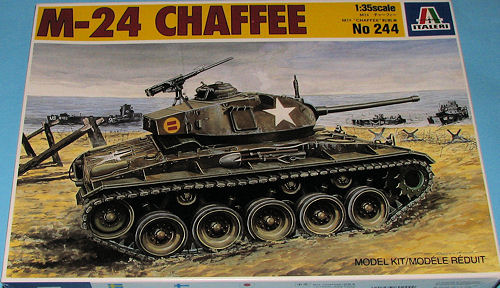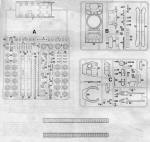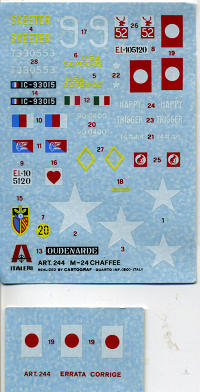
| KIT #: | 244 |
| PRICE: | $15.00 SRP when new |
| DECALS: | options |
| REVIEWER: | Scott Van Aken |
| NOTES: |

| HISTORY |
The Light Tank M24 was an American light tank used during World War II and in postwar conflicts including the Korean War and with the French in the War in Algeria and First Indochina War. In British service it was given the service name Chaffee, after the United States Army General Adna R. Chaffee, Jr., who helped develop the use of tanks in the United States armed forces.
The M24 Chaffee was intended to replace the aging and obsolete Light Tank M5 (Stuart) which was used in supplementary roles. The first thirty-four M24s reached Europe in November 1944 and were issued to the U.S. 2nd Cavalry Group (Mechanized) in France. These were then issued to F Company, 2nd Cavalry Reconnaissance Battalion and F Company, 42nd Cavalry Reconnaissance Battalion which each received seventeen M24s. During the Battle of the Bulge in December 1944, these units and their new tanks were rushed to the southern sector; two of the M24s were detached to serve with the 740th Tank Battalion of the U.S. First Army.
The M24 started to enter widespread issue in December 1944 but they were slow in reaching the front-line combat units. By the end of the war many armored divisions were still mainly equipped with the M5. Some armored divisions did not receive their first M24s until the war was over.
Reports from the armored divisions that received them prior to the end of hostilities were generally positive. Crews liked the improved off-road performance and reliability, but were most appreciative of the 75 mm main gun, as a vast improvement over the 37 mm. The M24 was not up to the challenge of fighting German tanks, but the bigger gun at least gave its crews a chance to fight back when it was required. The M24's light armor made it vulnerable to virtually all German tanks, anti-tank guns, and hand-held anti-tank weapons. The contribution of the M24 to winning the war in Europe was insignificant, as too few arrived too late to replace the worn-out M5s of the armored divisions.
In the Korean War M24s were the initial U.S. tanks directed to combat the North Korean T-34-85s. The M24 fared poorly against these better armed and better armored medium tanks. M24s were more successful later in the war in their reconnaissance role, supported by heavier tanks such as the M4, M26, and M46.
Like other successful World War II designs, the M24 was supplied to many armies around the globe and was used in local conflicts long after it had been replaced in the U.S. Army by the M41 Walker Bulldog. France employed its M24s in Indo-China in infantry support missions, with good results. They employed ten M24s in the Battle of Dien Bien Phu. In December 1953 ten disassembled Chaffees were transported by air to provide fire support to the garrison. They fired about 15,000 shells in the long siege that followed before the Viet Minh forces conquered the camp in May 1954. France also deployed the M24 in Algeria. The last time the M24 is known to have been in action was in the Indo-Pakistani War of 1971, where some 66 Pakistani Chaffees stationed in Bangladesh were easy prey for Indian Army T-55s, PT-76s, and anti-tank teams. Although both Iran and Iraq had M24s prior to the Iran–Iraq War, there is no report of their use in that conflict.
| THE KIT |
 I have always liked the Chaffee. To me it just looks right and so typically American. Several dozen years back, I built the ESCI kit of this tank and when I saw this one on the dealer shelves, I bought it and carefully hoarded it away for future building. Well, I never did get around to it, but still have plans.
I have always liked the Chaffee. To me it just looks right and so typically American. Several dozen years back, I built the ESCI kit of this tank and when I saw this one on the dealer shelves, I bought it and carefully hoarded it away for future building. Well, I never did get around to it, but still have plans.
This is a very typical Italeri armor kit. The molding is superb though like old Italeri kits, there are ejector pin marks in some of the most inaccessible places, such as the inside of the fender braces and the inside of hatches where one would destroy any detail to get to them.
The kit comes with a pretty complete gun including the breech assembly and the guards around th is area. Of course, there is no interior and one is supposed to build it with the hatches closed, though one can build them open without any problem if one has a figure to stick in there.
is area. Of course, there is no interior and one is supposed to build it with the hatches closed, though one can build them open without any problem if one has a figure to stick in there.
Just about all the hardware and a myriad of hand holds and other small bits are there to fit on the outside. The placement areas for the tools are engraved on the areas to which they fit. There is also a bit ITALERI logo embossed on the bottom of the hull that many will want to remove. The kit comes with 'rubber band' style tracks that are to have the connecting pins heated. Now the reason I am doing this preview is that I popped off the shrink wrap from this one to give the tracks to a friend whose kit did not have any. Much to my dismay, both of the tracks were short shot. Fortunately, there are aftermarket tracks for this one so it is not a major loss.
Instructions are well done with nicely drawn construction steps and there is color information provided during the build process; all the colors are generic. I liked that there are photos of the completed kit included as these could well be useful in helping to put bits in the right place. The markings are for five vehicles, all in OD. The US version is the box art tank that is simply listed as NW Europe 1944. There are also tanks from France in IndoChina during 1952, A british tank from Germany in 1945, an Italian tank from 1953 and finally, a Japanese tank from 1957 (Godzilla!). I doubt the decals are still any good, but perhaps they can be salvaged.
| CONCLUSIONS |
Until the recent release of the Bronco kit, this was it for Chaffees in this scale (at least I do not know of any others). Still, this one can be found for considerably less than the Bronco version and should make into a very nice model.
| REFERENCES |
May2012 If you would like your product reviewed fairly and fairly quickly, please contact the editor or see other details in the